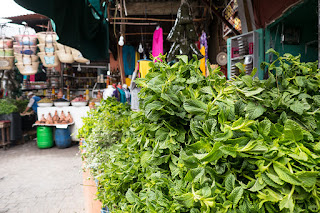Twenty-two degrees hotter than Vancouver two days ago, and in an airport with no AC, I was soon dripping. About 45 minutes after I retrieved my bags, my driver showed up and drove me into the heart of this big city amid gridlock and no AC. I was not nice to know on arrival and immediately met two fellow tour members. I scurried off to shower thinking about Morocco.
I vividly recalled the red earth of Africa and here it was again welcoming me back. A rich, deep orange that colours Morocco in buildings, art, pottery, and interior design.

Many fields surround Casablanca, the largest city in Morocco of over 5 million. The north is agricultural and the crops here feed the country. Beans, mint, the sweetest tomatoes I've ever tasted, barley, onions, and more. winter is the rainy season.
The smell of the heat, sweat, and animals could not be missed either, and in certain areas dust and dirt covered everything. Some small towns looked as if they'd been sprayed with garbage, while others were spotless.
 |
| An untidy Stork's nest, Rabat |
I'd forgotten that storks breed in North Africa. Their untidy nests were all over the place on poles, towers and minarets, and because it was breeding season, the birds were busy clacking their beaks to attract a mate.
Traffic followed no rules. Three lanes were always four, vehicles drove straddling the lane markers and, on narrow roads, they occupied the middle, playing chicken with oncoming traffic. Roundabouts abound in Morocco and, as far as I could see, no-one and everyone had right of way. Drivers were out to beat others and win! Cities were slow-going in a vehicle. Pedestrians crossed roads with extreme caution. It was chaotic and terrifying for an orderly Canadian.
Hundreds of donkeys, mules, and small horses pulled carts laden with produce headed for the markets and souks. Mint, fava beans, nuts, even plastic chairs. Some animals were obviously well cared for but others were not. Donkeys without carts carried heavy panniers and sometimes a farmer rode sideways.
Outside the cities, every flock of sheep or goats, however small or large, had a shepherd. Mainly teen boys, but the odd female too. My Explore guides told us that they had all done this — "It builds responsibility and self-reliance," I was assured.
 |
| Date palms in Tinghir |
 |
| Abandoned fort near Merzouga |
The days grew hotter and drier until we reached the edge of the Sahara. The buildings changed too — now built of red sandstone adobe and very ancient. This was the Morocco I'd been expecting and I loved it. Our guide explained, "The buildings come from the desert and, once abandoned, crumble back into it, leaving no trace."
Here hotels were built like red forts and rooms were arranged around lush courtyards full of birdsong and flowers. Windows were tiny and often the AC didn't work. Hospitality became more obvious and more friendly — we were met with mint tea in the reception areas and had willing help with baggage to our rooms.
 |
| Tajines in the Meknes market |
Food was cheap and, if you stuck to tajines, quintessentially Moroccan. Tajines are the conical pottery in which lamb, beef or chicken stews are cooked. Delicious fare. Pizzas are prevalent in all cafes and are often dismal. Burgers likewise, but they were not for me. Almost everyone on our tour suffered from tummy trouble and our leader handed out Imodium like candy! Tap water is not for drinking, so soon we all learned to buy about three litres of bottled water every day — under $2.
My penultimate impression about travel in Morocco is that it is a cash country. The currency is Dirhams, 7.45dh to CAD$1.00. I was glad I carried more than one bank's debit card as my RBC card didn't work that well here. Tipping is a way of life too. So is haggling over price, except in pharmacies and supermarkets.
And then there are the camels — hundreds of them around the towns on the edge of the Sahara. But actually they are dromedaries with one hump....
 |
| Dusk falls on a caravan in the Sahara |
ALL IMAGES: © Photos by Pharos 2017
All rights reserved

No comments:
Post a Comment